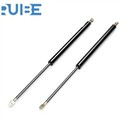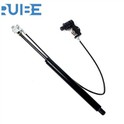Hey there! As a gas spring supplier, I often get asked about how to mount a gas spring on a cabinet. It might seem a bit tricky at first, but with the right steps and a little know - how, you'll have your cabinet gas spring installed in no time. In this blog, I'll walk you through the whole process.
What Are Gas Springs and Why Use Them?
Before we jump into the installation, let's quickly talk about what gas springs are. Gas springs are these nifty devices that use compressed gas to provide smooth and controlled motion. They're super useful for cabinets because they can help you easily open and close cabinet doors or lids.
There are different types of gas springs for various applications. For instance, if you're looking for a gas spring for your car bonnet, check out our Bonnet Gas Spring. And if it's for furniture, our Gas Lift for Furniture is a great option. For kitchen cabinets, we've got the Kitchen Cabinet Gas Spring.
Tools You'll Need
To mount a gas spring on a cabinet, you'll need a few tools. Here's a list:
- Screwdriver: You'll use this to secure the brackets and other parts. A Phillips - head screwdriver is usually a good choice, but it depends on the type of screws you have.
- Measuring Tape: This is crucial for getting the right measurements. You need to make sure the gas spring is installed in the correct position.
- Pliers: Pliers can come in handy for bending or adjusting some of the parts, especially if you need to make small tweaks during the installation.
- Drill (Optional): If you need to create holes for the brackets, a drill will be necessary. Make sure you have the right drill bits for the material of your cabinet.
Step - by - Step Installation Guide
Step 1: Measure and Plan
The first thing you need to do is measure your cabinet. You need to figure out where the gas spring will be installed. Measure the height and width of the cabinet door or lid. Also, think about the position where the gas spring will provide the best support.
Typically, you'll want to install the gas spring near the hinge of the cabinet door. This helps to distribute the weight evenly and ensures smooth operation. Mark the spots where you'll attach the brackets for the gas spring.
Step 2: Attach the Mounting Brackets
Once you've marked the spots, it's time to attach the mounting brackets. If your cabinet is made of wood, you can usually just screw the brackets into place using a screwdriver. If it's metal or another material, you might need to use a drill to create holes first.


Make sure the brackets are firmly attached. You don't want them to come loose later on. Double - check the alignment of the brackets to ensure they're in the right position.
Step 3: Mount the Gas Spring
Now it's time to mount the gas spring itself. One end of the gas spring will attach to the bracket on the cabinet body, and the other end will attach to the bracket on the cabinet door or lid.
Most gas springs have a ball - joint connection. You can simply insert the ball of the gas spring into the socket on the bracket. If it's a bit tight, you can use pliers to help you get it in place. Be careful not to damage the gas spring or the brackets during this process.
Step 4: Test the Installation
After mounting the gas spring, it's important to test it. Open and close the cabinet door or lid a few times. Check if the gas spring is providing enough support. The door should open and close smoothly without any jerks or sticking.
If the door doesn't open or close properly, you might need to make some adjustments. You can try moving the brackets slightly or checking if the gas spring is fully seated in the brackets.
Step 5: Make Adjustments (if necessary)
If you notice any issues during the test, you'll need to make adjustments. For example, if the door doesn't stay open, you might need to increase the tension of the gas spring. Some gas springs have an adjustable valve that allows you to do this.
If the door is too difficult to open or close, you might need to re - position the brackets or check if the gas spring is the right size for your cabinet.
Tips and Tricks
- Choose the Right Gas Spring: Make sure you select the right gas spring for your cabinet. Consider the weight and size of the cabinet door or lid. If you're not sure, you can always contact us, and we'll help you choose the best one.
- Lubricate the Moving Parts: Over time, the moving parts of the gas spring can get a bit dry. You can use a light lubricant to keep them moving smoothly. Just be careful not to use too much lubricant, as it can attract dust and dirt.
- Regular Maintenance: Check the gas spring and the brackets regularly for any signs of wear or damage. If you notice any problems, replace the parts as soon as possible to avoid further issues.
Conclusion
Mounting a gas spring on a cabinet isn't as difficult as it might seem. By following these steps and using the right tools, you can have your cabinet gas spring installed and working properly in no time.
If you're in the market for high - quality gas springs, we're here to help. We've got a wide range of gas springs for different applications, including Bonnet Gas Spring, Gas Lift for Furniture, and Kitchen Cabinet Gas Spring.
If you have any questions about choosing the right gas spring or the installation process, feel free to reach out to us. We're always happy to assist you with your gas spring needs and look forward to discussing your procurement requirements.
References
- General knowledge of gas spring installation from industry experience.
- Manufacturer's guidelines for gas spring installation.






